To make your soap bar last longer, keep it dry between uses on a well-draining soap dish that allows airflow. Choose harder soaps containing coconut or palm oils, and opt for properly cured bars (4-6 weeks minimum). Limit hot water exposure, as it accelerates dissolution. Consider your water type—hard water can extend bar life despite reduced lather. For homemade soaps, longer curing times greatly improve durability. These simple adjustments can transform your soap from a short-lived expense into a lasting investment.
What Makes Your Soap Bar Last Longer?
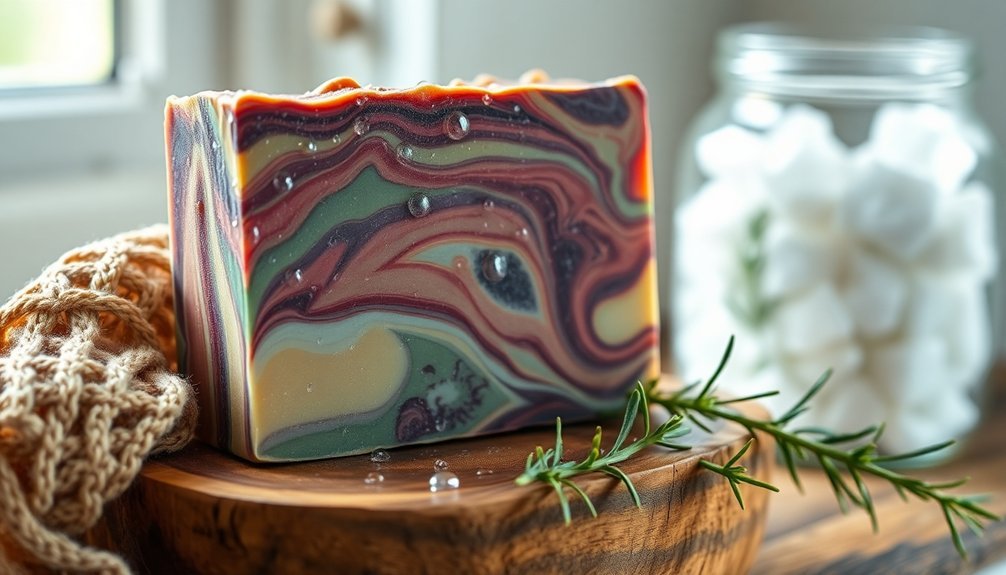
When you invest in a quality soap bar, understanding what affects its longevity can save you money and reduce waste. The composition of your soap greatly impacts durability—bars containing coconut oil typically last longer due to their harder texture.
Your water quality matters too; hard water can accelerate soap deterioration.
How you use your soap also determines its lifespan—sharing among multiple household members will naturally shorten it. Daily use typically consumes 6-7 grams of soap per shower.
Storage conditions are essential: keeping your soap properly dried between uses prevents unnecessary erosion. For handmade soaps, longer curing times often result in more durable bars.
Environmental factors like humidity and temperature variations can affect longevity, while direct water exposure quickly erodes even the hardiest soap.
Consider using a soap saver or draining dish to maintain air circulation around your bar.
The Science Behind Soap Erosion Rates
The physical breakdown of soap isn't just a bathroom inconvenience—it's a fascinating scientific process. Your soap erodes through both chemical reactions with water and mechanical disintegration from physical forces.
When your soap sits in standing water, it slowly dissolves as water molecules interact with its surface. However, the erosion accelerates dramatically when exposed to spraying or flowing water, similar to how rivers carve through rock. An experiment with soap chunks demonstrated that moving water caused a significant 78cm decrease in soap size after spraying, while standing water had minimal impact.
High humidity in your bathroom can soften soap, making it more susceptible to breakdown. Temperature fluctuations and the quality of raw materials in your soap also influence erosion rates.
Experiments show that while soaking causes minimal initial breakdown, direct water spray creates rapid disintegration. Understanding these mechanisms explains why proper storage—keeping your soap dry between uses—significantly extends its lifespan.
Measuring Hardness as a Predictor of Longevity
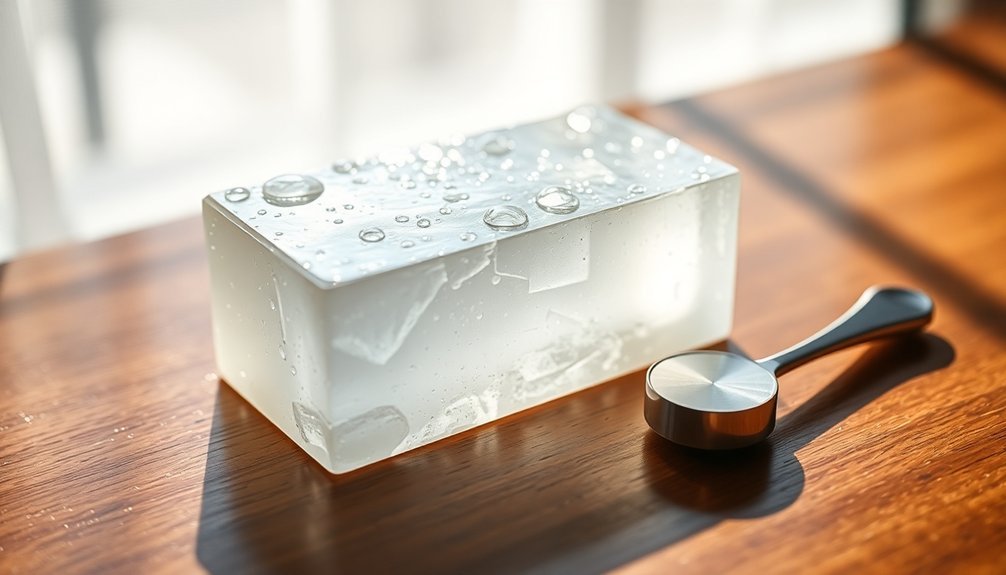
While many soap users focus on fragrance or color, hardness serves as the most reliable predictor of how long your soap will last. This hardness is primarily determined by the concentration of saturated fatty acids like lauric, myristic, palmitic, and stearic acids in your soap formula.
SoapCalc measures hardness on a scale where 29-54 is considered ideal. You'll find oils high in saturated fats—coconut and palm oil specifically—contribute notably to both hardness and longevity. For example, Castile soap made with 100% olive oil has a hardness number of only 17 due to its low saturated fatty acid content, resulting in a softer bar that dissolves more quickly.
Aim for SoapCalc hardness values between 29-54, prioritizing coconut and palm oils for longer-lasting bars.
The curing process also plays a vital role; as water evaporates, your soap becomes harder and less soluble. For accurate assessment, you should consider both the calculated hardness number and the physical hardness achieved through proper curing.
A balanced ratio of saturated to unsaturated fats (around 54:46) offers the best durability without sacrificing moisturizing properties.
Water Quality's Impact on Soap Bar Durability
Few factors impact your soap's longevity as importantly as water quality.
Hard water, containing high mineral content, reduces lathering efficiency but may actually extend your bar's life compared to soft water, which creates abundant lather that can wash away more soap per use.
Temperature matters greatly—hot water dissolves soap faster, while cool water preserves it. You'll find your soap bars lasting longer when you switch to warm or cool water for routine washing.
Proper drainage is essential between uses. An angled soap dish that allows water to flow away prevents your bar from sitting in moisture and dissolving prematurely. For natural soap bars, this is particularly important as they tend to have a shorter lifespan due to their softer ingredient composition.
Consider regional variations in your water supply too—high mineral content areas may require different soap storage strategies than regions with naturally softer water.
Optimal Curing Times for Maximum Bar Lifespan
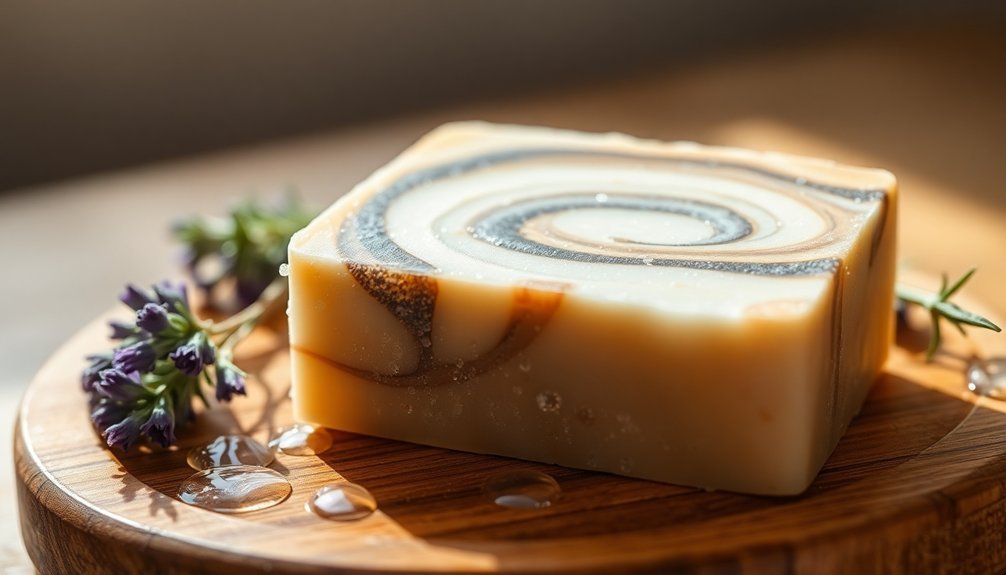
Proper curing of your handmade soap bars requires a minimum of 4-6 weeks to maximize longevity and performance.
During this critical waiting period, excess moisture gradually evaporates from the soap, creating a harder, longer-lasting bar that won't dissolve quickly with use.
You'll know your soap has reached ideal curing when its weight stabilizes over two consecutive weeks, indicating it's ready to provide the best possible bathing experience.
Soaps with higher percentages of soft oils like olive oil typically require longer curing times to reach their optimal hardness and performance.
Minimum Weeks Required
Although many soap users don't realize it, the curing time of a handmade soap bar directly impacts how long it'll last in your shower. For peak performance and longevity, most handmade soaps require a minimum of 4-6 weeks of curing time before use.
When your soap reaches its proper curing time, you'll notice:
- A harder bar that dissolves more slowly when used
- Better lathering properties that enhance your shower experience
- Extended lifespan, saving you money in the long run
Soaps made with softer oils like olive oil need even longer—often 6 weeks or more. Proper curing ensures all lye is neutralized, making the soap safe for your skin.
If you're making your own soap, remember that smaller bars cure faster due to their higher surface-to-volume ratio. When a bar maintains consistent weight over several days, it's ready to use.
Moisture Evaporation Process
The molecular magic of soap curing happens primarily through moisture evaporation—a process that transforms your soft, newly-made soap into a long-lasting shower companion.
As water leaves the bar, soap molecules crystallize, creating a harder, more durable structure.
Your recipe's water content directly influences curing time—higher moisture levels require longer evaporation periods, while lower water concentrations yield faster-hardening bars.
The oils you choose also affect how your soap retains moisture during curing.
Environmental humidity plays an essential role too. You'll notice bars cure more slowly in humid conditions but faster in dry environments.
Experiments show that cold process soaps lose approximately 15% of weight during proper curing, significantly improving their longevity.
For best results, store your curing soaps in well-ventilated areas away from moisture sources.
Using a dehumidifier or increasing airflow can accelerate the process, especially if you live in a naturally humid climate.
Temperature-Controlled Testing Environments
When manufacturers want to understand how their products perform in extreme conditions, they turn to temperature-controlled testing environments.
These sophisticated chambers can simulate everything from arctic cold to desert heat, helping companies guarantee their products—including your soap—will maintain integrity in varied conditions. This testing process can simulate temperatures ranging from -70°C to +150°C to identify potential weaknesses in product formulations.
While not directly applied to soap bar testing, the principles from these environments inform proper soap storage:
- Store your soap in a cool, dry place away from direct sunlight to prevent premature melting or degradation.
- Use a well-draining soap dish that allows air circulation to speed moisture evaporation.
- Consider seasonal humidity changes, which may require adjusting where you store your soap.
Understanding these environmental factors can greatly extend your soap bar's life, saving you money and reducing waste.
Weighing Methods to Track Soap Dissolution
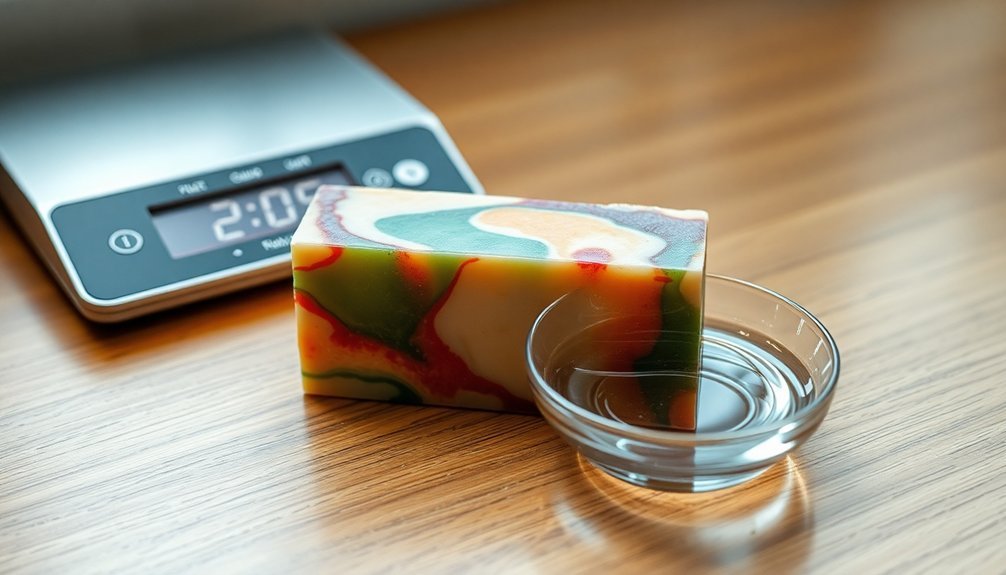
Tracking your soap's weight with an analytical balance gives you precise data on how quickly it's dissolving during use.
You'll want to weigh your soap at regular intervals, recording the measurements to identify dissolution patterns and calculate the rate of use over time.
Environmental factors like moisture exposure, drainage conditions, and airflow around your soap bar will greatly impact these dissolution rates, so controlling these variables helps extend your soap's lifespan.
Soaps with higher moisture content will typically dissolve faster, as seen in commercial soaps where moisture levels range from 10.91% to 22.69%.
Daily Tracking Techniques
Monitoring your soap's lifespan requires systematic observation and data collection. You'll need reliable tools and consistent methods to accurately gauge how quickly your bar soap disappears with daily use.
- Digital weighing: Use a kitchen scale for precise measurements, weighing your soap at the same time each day to track gram-by-gram dissolution.
- Visual documentation: Take regular photos or note physical changes in your soap's size and shape to complement weight data.
- Usage logging: Record each use in a simple notebook or smartphone app, noting details like water temperature and duration. Soap with higher water content may dissolve more quickly as water ratios significantly affect a bar's longevity.
Standardize your tracking process by creating a dedicated spot for both your soap and measurement tools. This consistency eliminates variables that might skew your results, giving you reliable data about what factors truly extend your soap's lifespan.
Dissolution Rate Factors
Soap dissolution rates vary dramatically based on several key factors that you can measure systematically. By tracking your bar's weight regularly with a digital kitchen scale, you'll gain precise data on how quickly it's dissolving under your specific conditions.
Environmental factors greatly impact dissolution speed—hard water dissolves soap faster than soft water, while hot showers accelerate the process compared to cooler temperatures. Handcrafted soaps containing natural glycerin content will dissolve noticeably faster than commercial varieties where this moisturizing byproduct has been removed. Your storage method matters too; a well-ventilated soap dish that allows complete drying between uses can extend your bar's life substantially.
The soap's composition itself plays a vital role. Bars with high glycerin content or moisturizing additives typically dissolve faster, while dense, well-cured soaps with minimal porosity resist breakdown more effectively.
These physical properties determine how your soap interacts with water during each use.
Mechanical Abrasion Simulation Techniques
While most consumers focus on soap ingredients, understanding how your soap physically wears away is equally important for extending its lifespan.
Scientists use advanced simulation techniques to study how your bar soap responds to daily use, predicting wear patterns before products even reach your shower.
These simulations analyze:
- Surface interactions between your soap and washcloth, revealing ideal bar shapes that resist excessive wear
- Friction forces that determine how quickly material is removed during each use
- Environmental factors like water temperature that greatly impact abrasion rates
Storage Conditions and Their Measurable Effects
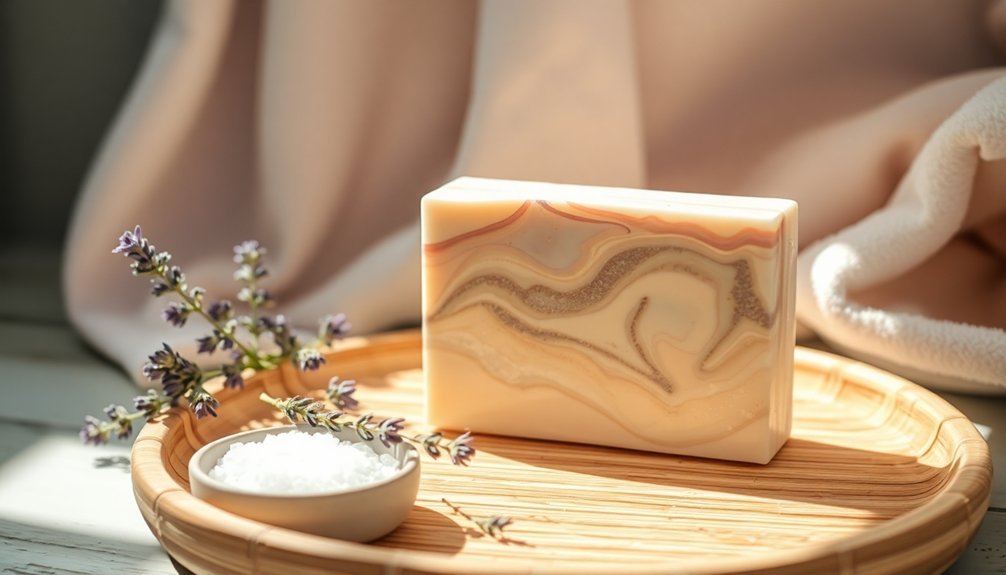
Beyond mechanical wear patterns, where you store your soap makes a measurable difference in how long it lasts.
Keeping bars in cool, dry, well-ventilated areas away from direct sunlight can extend their lifespan considerably.
Your choice of soap dish matters immensely—those with drainage holes prevent water accumulation that accelerates soap dissolution.
Raised designs or hanging solutions keep bars from sitting in puddles between uses.
For maximum preservation, store bars in linen closets rather than humid bathroom floors.
Temperature stability is essential; avoid exposing soap to extreme heat or cold.
You'll preserve both texture and fragrance by maintaining consistent conditions.
When using soap, minimize water exposure by briefly wetting it before lathering, and consider rotating between multiple bars to allow complete drying between uses.
Consider using a soap saver pouch that simultaneously exfoliates while providing proper airflow for drying between uses.
Oil Content Analysis and Longevity Correlation
The chemical composition of your bar soap—specifically its oil content—directly determines how long it will last in your shower.
Soaps made with higher percentages of saturated fats form harder, more durable bars that dissolve slower when exposed to water. Using SoapCalc, you can estimate longevity by subtracting the cleansing value from the hardness value, or by calculating the sum of palmitic and stearic acid content.
- Coconut oil creates hardness but can decrease longevity due to high cleansing properties that dissolve faster.
- Palm oil, tallow, and lard contribute considerably to bar durability through their high saturated fat content.
- A balanced ratio between saturated fats (for hardness) and unsaturated fats (for conditioning) optimizes both longevity and skin benefits.
The ideal combined content of palmitic and stearic acids for maximum soap longevity is typically in the 30% to 40% range.
Humidity Resistance Testing Protocols
Testing soap bars for humidity resistance requires standardized protocols that accurately simulate real-world conditions.
You'll find controlled humidity chambers particularly valuable as they create consistent environments to evaluate how your soap performs under different moisture levels.
Accelerated aging tests offer efficient insights by subjecting your soap to elevated humidity and temperature, compressing months of exposure into days.
Moisture sensitivity analysis helps you determine the specific humidity thresholds at which your soap begins to deteriorate. Chemical analysis procedures provide precise measurements of moisture content in soap bars containing synthetic detergents.
Water absorption tests measure how quickly your soap takes on moisture—a key indicator of its longevity in your shower.
Statistical Approaches to Soap Degradation Analysis
When you're comparing soap durability, statistical methods like confidence intervals and regression models provide essential insight into degradation rates over time.
Your experimental design should include multiple samples under identical conditions to guarantee reliable results and minimize random variation that could skew your findings.
Tracking key metrics such as weight loss percentage, dimensional changes, and pH shifts will give you quantifiable data to determine which soaps truly offer superior longevity. Environmental factors like heat and moisture can trigger significant degradation events, similar to how they affect materials in other applications.
Degradation Rate Metrics
Although soap bars seem like simple products, measuring their degradation involves sophisticated statistical approaches that can predict longevity with remarkable accuracy.
When researchers analyze how quickly your soap dissolves, they're applying complex statistical models that account for multiple variables simultaneously.
- Time-to-dissolution metrics track the average lifespan of your soap bar, typically measuring weight loss over time under controlled conditions.
- Regression analysis helps you understand which factors most greatly impact longevity—whether it's water hardness, usage frequency, or soap composition.
- Environmental impact indices quantify biodegradability rates, showing how quickly your soap breaks down into harmless components after use.
The biodegradability of traditional soaps made from plant oils or animal fats makes them generally less harmful to aquatic ecosystems than synthetic detergents.
You'll find that properly cured, dense soaps with natural ingredients consistently outperform others in these metrics, especially when stored away from excessive humidity.
Experimental Trial Design
To accurately measure a soap bar's longevity, researchers have developed sophisticated experimental designs that isolate and quantify degradation factors. These trials typically include control groups using standard soaps against treatment groups with varied conditions like water hardness or storage methods.
You'll find that properly designed experiments incorporate randomization to prevent bias and statistical methods like ANOVA or regression analysis to interpret results. Researchers apply survival analysis to predict how long your soap will last under specific conditions, while repeated measures track degradation over time. Studies show that consumer behavior during the use phase significantly influences the ecological footprint of washing bar soap.
Sample size matters—too few soap bars tested won't yield statistically significant results.
When reviewing soap longevity studies, look for blinded trials where data collectors didn't know which samples belonged to which test group, ensuring objective measurements of weight loss and degradation rates.
Comparative Wear Testing of Different Formulations
Since soap bars vary widely in their formulations, standardized testing becomes essential to accurately determine which types last longest. To compare different soaps fairly, you'll need to control variables like water quality, temperature, and usage patterns across all samples.
- Weigh each soap bar before testing and at regular intervals to track quantitative changes in mass over time.
- Create identical usage conditions by ensuring each soap receives the same water exposure and handling techniques.
- Evaluate lather characteristics alongside physical wear to understand the relationship between efficient lathering and longevity.
Experienced soapmakers often use multiple batches simultaneously during testing to make direct comparisons between different formulations.
Higher fatty acid content typically results in harder, more durable bars. By conducting side-by-side comparisons under controlled conditions, you'll identify which ingredients and formulations truly contribute to a longer-lasting soap, beyond marketing claims.
Frequently Asked Questions
Can I Revive Dried-Out or Cracked Soap Bars?
Yes, you can revive dried-out soap by rebatching—grate and melt it with added moisture in a slow cooker. For cracked soap, try squirting high-proof alcohol over cracks or use plastic wrap to smooth them down.
How Does Fragrance Type Affect Soap Bar Longevity?
Fragrance type impacts your soap's durability. Essential oils fade faster while synthetic fragrance oils last longer. Synthetic oils won't affect soap structure, but essential oils with higher volatility may lead to quicker overall deterioration.
Does Freezing Soap Before Use Make It Last Longer?
No, freezing soap before use doesn't make it last longer. While freezing won't harm fully cured soap, it doesn't extend its lifespan. You'll get better results using a soap dish with good drainage instead.
Are Antibacterial Soaps More Durable Than Regular Ones?
No, antibacterial soaps aren't more durable than regular ones. Their added chemicals don't extend longevity, and they may actually deteriorate faster. You'll find soap durability depends more on storage and usage patterns than antibacterial properties.
Can I Combine Soap Scraps to Create a New Bar?
Yes, you can combine soap scraps to create a new bar! Try grating them, melting with minimal water, or using the pressure method. You'll reduce waste and save money while giving those scraps new life.
In Summary
You'll extend your soap's life by keeping it dry between uses, using a soap dish with drainage, avoiding hot water, and selecting harder bars with longer curing times. Oil content matters too—those with higher percentages of hard oils like coconut and palm typically outlast softer formulations. Your water quality plays a role, so consider this when comparing bar longevity across different household environments.

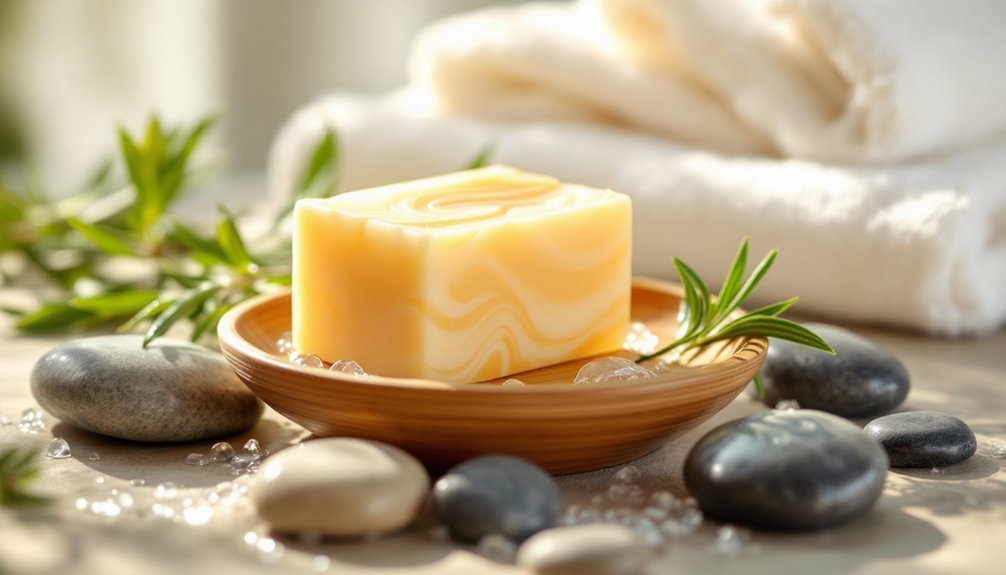



Leave a Reply